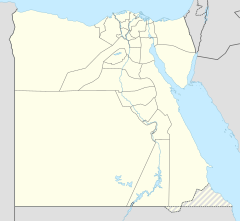Aqsunqur Mosque
| Aqsunqur Mosque Blue Mosque | |
|---|---|
Darb al-Ahmar district), Islamic Cairo, Egypt | |
| Geographic coordinates | 30°02′10″N 31°15′36″E / 30.036°N 31.260°E |
| Architecture | |
| Architect(s) | Shams ad-Din Aqsunqur |
| Type | Mosque |
| Style | Mamluk, Ottoman |
| Completed | 1347, then early 1652 |
| Specifications | |
| Dome(s) | 5 |
| Minaret(s) | 1 |
| Materials | Stalactite, brick, wood, marble |
The Aqsunqur Mosque (
History
Construction under Mamluks

The mosque was built in 1347 on the orders of the
Medieval
By the 15th century the Aqsunqur Mosque was reportedly in poor shape due to the loss of
Restoration by Ottomans

Between 1652 and 1654, during
Ibrahim Agha built his mausoleum, which was also decorated with marble tiles, in the southern hall. It was constructed using the typical Mamluk architectural style and included a mihrab ("prayer niche") resembling the mausoleums of Mamluk emirs also located in the mosque complex. In line with Ottoman tradition at the time, the Aqsunqur Mosque was officially renamed after its restorer as the "Ibrahim Agha Mosque." The latter name was not used frequently.[3]
Modern era
In 1908 the Aqsunqur Mosque was restored by the Comité de Conservation des Monuments de l'Art Arabe. The 1992 Cairo earthquake damaged the arches of the mosque's porticoes, but they were reinforced by the Egyptian government in the mid-1990s to prevent additional deterioration.[5]
The Aga Khan Trust for Culture (AKTC) in conjunction with the World Monuments Fund began a restoration project of the mosque in 2009.[4] The Mosque opened to the public in May 2015 after the completion of a six-year renovation project. The mosque was inaugurated in presence of Antiquities Minister Mamdouh el-Damaty, the Aga Khan, the Chairman of the Aga Khan Development Network, and Cairo governor Galal Saeed.
Renovation work focused structural stability, conservation of the interior and roof repair.[5] Today, the Aqsunqur Mosque is a major destination for tourists visiting Egypt.[6]
Architecture
Exterior
The general layout of the mosque consists of a large open courtyard (
Kujuk's mausoleum is situated at the portal's northern side and has two
Above the prayer hall sits a brick one-bay dome carried on four brick squinches. A large brick dome supported by brick squinches is also situated atop the mausoleum of Kujuk. However, the latter has a pendentive below each squinch. When the mosque was originally built this technique of using plain squinches was considered archaic.[7]
Interior

The mosque's interior also has an irregular layout mostly due to Ibrahim Agha's renovations which replaced most of the original
The
Minaret
The minaret is situated at the southern corner of the facade looking into
See also
- Lists of mosques
- List of mosques in Africa
- List of mosques in Egypt
- Islamic architecture
- Sultan Ahmed Mosque
- Timeline of Islamic history
References
- ^ a b c d Behrens-Abouseif, p.115.
- ^ a b c d e f Williams, p.86.
- ^ a b c d e f g h i j k Behrens-Abouseif, p.116.
- ^ a b c d Williams, p.87.
- ^ a b Jama'ah al-Aqsunqur: Preserving an Early Mamluk Monument and Its Exceptional Iznik Decoration. World Monuments Fund.
- ^ Williams, p.85.
- ^ a b c Amir Aqsunqur Funerary Complex Archived October 10, 2012, at the Wayback Machine. ArchNet Digital Library.
Bibliography
- Behrens-Abouseif, Doris (1989), Architecture of the Bahri Mamluks (PDF document), BRILL
- Williams, Caroline (2008), Islamic monuments in Cairo, American University of Cairo Press, ISBN 978-9774162053





